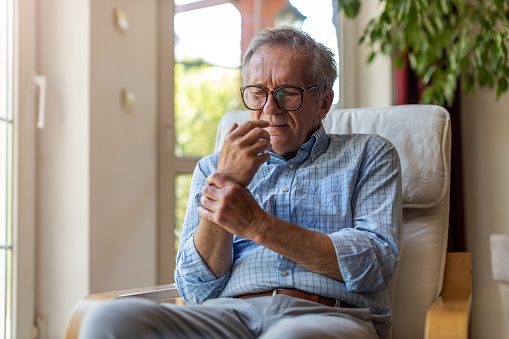Osteoporosis is the reduction of bone mineral density. In other words, bones become fragile and are prone to fracture. Osteoporosis is a common condition as we age. Osteoporosis is sometimes called "the silent thief," because the first warning sign is too often a bone fracture.
In Canada, osteoporosis affects about one out of four women and one out of eight men over 50. Though, there is still hope; in this guide, you will get to know the most critical points about osteoporosis and how to prevent, delay, and treat it.
Osteoporosis, How does it occur?
Typically, our bodies renew our bones in a process called "bone remodelling."Bone remodelling means that your body removes old or aging bone and rebuilds. This process, like so many in the body, is a delicate balance; maintaining bone mass and strength to reduce the risk of fracture.
As we age, bone density loss overtakes bone building. The result is less dense bones that are more vulnerable to fracture. Osteoporosis in older adults often occurs in the hip, spine, and wrists.
Causes and risk factors
As mentioned above, as bone remodelling slows, we see lower bone mineral density, AKA osteoporosis. There are exacerbating risk factors for osteoporosis as well as interventions we can use to slow the process. A systematic review published in the journal therapeutic advances in musculoskeletal disease mentioned the following points as common risk factors
- Age: Older adults and seniors after 50 are more prone to osteoporosis than younger people because bone formation slows as we age.
- Gender: Women have thinner and less dense bones than men to begin with. Elderly women are also more vulnerable to osteoporosis than men, especially after menopause. After menopause, women experience a significant reduction in estrogen levels, making them prone to postmenopausal osteoporosis.
- Calcium and vitamin D: Deficiency of calcium and vitamin D stimulates the secretion of more parathyroid hormone which takes the calcium in the bones out into circulation to meet the deficit. Thus resulting in bone loss and osteoporosis.
- Certain chronic conditions: Some medical conditions affect bone density directly or through the medication used to treat them. For instance, chronic lung disease, cancer, and overactive thyroid or parathyroid.
- Certain medications: Including glucocorticoids, some antiseizure drugs, and aluminum-containing antacids.
- Weight: Being underweight with a low BMI
- Smoking and alcohol: Tobacco and excessive alcohol intake are risk factors of osteoporosis
- Physical activity: Insufficient physical activity leading to reduced muscle strength
- Family history: If you have a family history of osteoporosis, this may increase your risk of having low bone mineral density
Diagnosis
There are no early symptomatic early warning signs of osteoporosis. That said, there are tests anyone at risk can undergo to determine if there's cause for concern: A bone mineral density test (BMD) or bone densitometry test (DXA or DEXA scan). This painless test feels much like getting an x-ray. It measures the bone mineral density to evaluate your chances of osteoporosis and bone breakdown.
What are the expected results?
Results of this test are reported as a T-score as follows:
- If the T score is -1 to +1. This indicates a normal bone density
- If the T-score is -1 to -2.5. This indicated a low bone density
- If the T-score is -2.5 or lower. This indicates osteoporosis
Who should go for this test?
Anyone who experiences a fragility fracture should undergo an osteoporosis test. Also, anyone that meets one of the following pre-conditions for osteoporosis:
- Anyone with a medical condition that potentially causes low bone density
- Anyone taking medications where decreased bone density is a possible side effect
- Anyone with a family history of osteoporosis
- People over the age of 50, Especially postmenopausal women
- A potential symptom, e.g. sudden unusual back pain or noticeably decreased height
Prevention
The following tips are recommended for you to reduce the risk of having osteoporosis or the hip fractures and spinal fractures that it can lead to.
Weight-bearing exercise: It is advisable to follow an exercise program that contains some weight-bearing exercises to improve your bone strength and muscle mass. Introducing some weights into your walk can help.
Get enough calcium: Calcium is critical in maintaining optimal bone mass. The recommended daily intake of calcium is 1000 to 1200 mg per day. Consume enough calcium-rich foods as part of an overall eating for optimal health plan. Where possible, include dairy (milk, yogurt, cheese), sesame, kale, broccoli, and Chinese cabbage.
Moreover, there are many calcium supplements. Speak to your doctor or a Mednow virtual care doctor or clinician about calcium supplementation.
Get enough vitamin D: vitamin D is critical for calcium absorption. Try to get exposure to the sun for around 15 minutes between 10 a.m to 3 p.m to get enough vitamin D. Additionally, vitamin D is present in some foods including mushrooms and fatty fish. Natural sources are always best but vitamin D supplementation is always an option.
Protein and potassium: Proteins is critical for strong bones. Furthermore, potassium improves calcium metabolism. According to NIH, the recommended daily potassium intake for men over 19 years is 3,400 mg, while for women it is 2,600 mg. Bananas, soybeans, potatoes, meats, poultry, fish, milk, yogurt and nuts are good natural sources of potassium.
Hormone replacement therapy: This is hormone therapy for postmenopausal women to supplement for reduced estrogen. There are some potential side effects and things to watch for in hormone replacement therapy; definitely something to discuss with your doctor or Mednow Virtual Care clinician.
Quit smoking: Smoking is a bad idea for any number of reasons, including its negative impact on bone mass.
Prevent falls: Falls are the most common reason for hip fractures in elderly patients. Hip fractures may lead to permanent disability. Fewer than 50% will experience a full recovery. Prevent falls by wearing comfortable shoes, not rushing, providing a safe environment inside your house, and wearing eyeglasses if you suffer from eyesight problems.
Alcohol and Caffeine: Don't consume alcohol or caffeine to excess. Your body, including your bones, will thank you.
Osteoporosis treatment
There is no one-size-fits-all treatment for osteoporosis. Treatment depends on many factors including current bone mass, the factors thought to be causing reduced bone mass and other patient-specific factors. There are five main treatments for osteoporosis, including Bisphosphonates, Calcitonin, Raloxifene, Denosumab and the Parathyroid hormone.
Final thoughts
Osteoporosis is a reduction in bone mineral density causing fragile bones that fracture more easily. Osteoporosis raises the risk of hip fractures among the aging population. By following the previous prevention tips, taking medications and / or supplements as prescribed, you can manage, slow the impact or even avoid osteoporosis and help your body create not just new healthy bone but tissue and muscles as well.
This article offers general information only and is not intended as medical or other professional advice. A healthcare provider should be consulted regarding your specific situation. While the information presented is believed to be factual and current, its accuracy is not guaranteed, and it should not be regarded as a complete analysis of the subjects discussed. All expressions of opinion reflect the judgment of the authors as of the date of publication and are subject to change. No endorsement of any third parties or their advice, opinions, information, products, or services is expressly given or implied by Mednow or its affiliates.
Get Started
